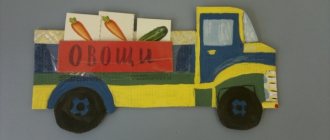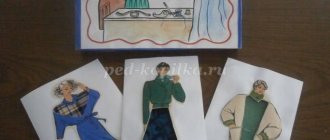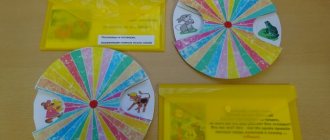Tangram. History of origin.
This famous puzzle comes from China. According to legend, it was invented by the teachers of the emperor’s son - a mathematician, artist and philosopher. With the help of an exciting game, they taught the lazy heir calculations and combinatorial thinking. They taught us to comprehend the beauty of images and to understand the complex world through simple figures. The puzzle is a square of seven geometric shapes. By moving and arranging the figures, you can come up with more than 6 million compositions. In China it is called “chi-chao-tu”. Translated as “seven planks of skill” or “pattern of seven smart parts.” In Europe, tangrams were made from expensive wood and ivory. Many historical celebrities were fond of it, such as Napoleon Bonaparte, Thomas Hill, Lewis Carroll.
Before the advent of computers and various electronic games, tangram was popular along with chess and dominoes. Currently, tangram is more often used in children's educational institutions for the development of children.
Tangram game for preschoolers: goals and objectives
Tangram develops many abilities. One of the goals of the tangram is to teach children to independently find solutions. By putting the figures in one order or another, preschoolers try different options, choosing the optimal composition in accordance with the given rules. The magic square, like other logical tasks and puzzles, perfectly activates mental activity and develops character.
Tasks:
- To develop in children memory, attention, fine motor skills, various types of thinking (logical, spatial, imaginative, constructive), intelligence, imagination,
- To develop children's perception of color and shape,
- Teach to follow instructions and play according to given rules,
- To develop perseverance and patience as necessary qualities for the future school period,
- To instill in children responsibility and a serious attitude towards completing the assigned task.
Methodological development “Educational and game correctional manual”. Didactic game “Continue the row”
Didactic game: “Continue the row”
Game “Continue the Row” for children from 2 to 7 years old. A manual on mathematics for preschool children. Aimed at developing logical thinking, attention, observation, memory, visual perception. With the help of this game, children learn to distinguish between geometric shapes (circle, square, triangle, oval) and primary colors (yellow, red, blue, green); follow the sequence of colored figures according to the proposed pattern in various variations.
The game includes math cards and a large number of flat geometric shapes of different colors that children can use to continue the series.
The cards depict geometric rows that are not repeated. Children must choose a card, carefully examine the series of figures drawn on it and continue it using the handout. During the game, you must name the geometric shape and color.
Card options vary in complexity. Children from 2-4 years old are offered simple versions of cards, where two geometric shapes in two colors alternate.
Children from 4-7 years old are offered more complex card options, where four geometric shapes in four colors alternate.
The duration of the game depends on the child’s interest. Help him if necessary, and be sure to praise him.
Target:
- for children from 2 to 4 years old - fix the name of the basic geometric shapes (square, rectangle, circle, oval) and primary colors (yellow, blue, red, green);
- for children from 4-7 years old - teach children to perform mental operations: continue rows of geometric shapes according to the pattern; fix the names of geometric shapes and primary colors.
Tasks:
NGO "Cognitive Development"
Teach children, through logical thinking, to continue rows of geometric shapes according to the pattern, to consolidate the names of geometric shapes.
NGO "Speech Development"
Activate active vocabulary on the topic: row, circle, square, triangle, oval, yellow, blue, red, green.
NGO "Social and communicative development"
To develop the ability to productively engage in the educational process, observe the rules of cultural behavior, develop perseverance and concentration.
NGO "Physical Development"
Develop fine motor skills of the fingers; develop visual concentration and coordination of movements; strengthen children's ability to navigate on a plane.
Material: cards made of white cardboard with drawn lines of different zigzag and linear shapes and geometric shapes of different colors attached to these lines and a large number of flat geometric shapes (squares, circles, triangles, ovals) of different colors - yellow, blue, red, green.
Progress of the game:
The teacher places a card in front of the child and asks them to consider and name the sequence of the proposed series with geometric shapes in primary colors. Then, using logical thinking, continue the series yourself.
At what age do they play tangram?
There are many opinions, successful and unsuccessful experiences of teaching geometric puzzles to children of different ages. Often, preschoolers 2.5 years old do not yet understand the rules of the game. Children 3-4 years old are quite capable of moving and folding figures, but they do not always have enough perseverance. As a rule, it ends with 2-3 compositions under the guidance of a teacher or mother, then a switch of attention and types of activities is required. But the most diligent children of 3.5 - 4 years old can already come up with images themselves or assemble them according to existing patterns. And if you interest them not just in composing figures, but in making a multi-colored tangram, and organically interweave a fairy tale, a narrative with elements of adventure and vivid images during the lesson, then preschoolers can independently come up with unexpected solutions to the puzzle.
At what age does a child start playing tangram? Each teacher or parent decides for himself. Children may master it very early, or may not show interest even in older preschool age. The child should be ready for puzzles of this kind.
The teacher should take into account that if the activity involves making a tangram with their own hands, then the children must be able to work with scissors.
Didactic game “Finish the row”
inna Ekimova
Didactic game “Finish the row”
«Finish the row
is an interesting game for logical thinking and color perception. The game informs preschoolers' cognitive interest, develops the child's perseverance, and reinforces the names of geometric shapes and colors. Children are very interested in this game several people play it , the children begin to develop a competitive spirit. Children also begin to share their experiences to collect their cards as quickly as possible. The child can also play this game together with the teacher.
Goal: to develop logical thinking, attention, visual coordination.
Objectives: to strengthen children’s ability to navigate on a plane.
- development of memory, attention, logical thinking.
— to form non-standard thinking during the game.
- promote the development of coordination of movements.
Equipment for the game: cards with lines of tracks of varying complexity, geometric figures of different colors and sizes made of cardboard.
Rules of the game: The child must complete the row according to the proposed pattern.
Game actions: The child puts geometric shapes on the card.
Progress of the game: The child takes a card with the image of paths and inserts geometric shapes according to the pattern in a certain sequence.
Complication of the game: Broken lines of tracks.
Game for children 5–7 years old “Numbers in a row” Goal: to provide children with the opportunity to demonstrate their knowledge, intelligence, and dexterity. 4 sets of cards are laid out in the middle of the hall.
Didactic game with geometric shapes “Continue the row and match by color” Feyzullaeva Tamila Shikhmagomedovna didactic game with geometric shapes “Continue the row and match by color” for senior preschool children. Didactic game “Number series” Didactic games are held with the aim of increasing the child’s level of awareness of the world around him. They develop powers of observation. Didactic game “Memo. My Novosibirsk." DIY printed board game for children GAME “MEMO. MY NOVOSIBIRSK" (didactic game 4+) Educators of MADOOU d/s No. 500: Gazieva Yu. V. Pokhlamkova L. N. Currently exists. Didactic game “Simple Game” in the middle group Didactic game: “Simple Game” middle group I would like to offer to your attention the didactic game “Simple Game”. I can say that. Didactic game “Make a Row” for children 5–7 years old” Good afternoon, friends! I am glad to welcome you again to my page! Today I wanted to present to your attention a didactic game in mathematics.
Tangram: a fairy tale with tasks
The most interesting option for a lesson with a magic square for children would be an activity in the form of a fairy tale. You can choose any fairy tale in accordance with the age interests of preschoolers.
Take, for example, the cartoon “The Adventures of Luntik and His Friends.” All of his characters are well known to preschoolers. You can invite them to collect the image of the main character - Luntik, Baba Kapa, General Sher, Kuzya, Bee, Vupsen and Pupsen, the toad Klava and others.
As a rule, all children remember the beginning of the fairy tale: “Once upon a time, a baby was born on the Moon...”. Further, in accordance with the plot of the selected series, the heroes can meet in a flower meadow (collect a flower), play a ball (collect a ball), sit at the table and drink tea with pie (collect a table, then dishes, pie...).
In accordance with the age characteristics and interests of preschoolers, the teacher can complicate the lesson by introducing a competitive element: boys collect male characters - Luntik, Kuzya, the spider Shnyuk, and girls - female characters - Mila, Baba Kapa, butterflies, toad Klava, leech, etc. .
You can also watch one of your favorite cartoon series with the kids and together choose images of characters and objects to compose them from tangram figures.
When offering tangram tasks to children, it is important for the teacher to remind preschoolers to follow the rules of the game.
The tangram game perfectly develops intelligence, imagination, logical thinking, and teaches the basics of geometry. The tangram game is undoubtedly useful for preschoolers.
Buy on Aliexpress
Buy on Aliexpress
Buy on Aliexpress
If you found the information on the site useful, please share it on social networks:
Progress of the lesson:
The teacher places a card in front of the child and suggests using logical thinking to continue the series with geometric shapes.
In the future, the game can be complicated by adding more complex cards and additional geometric shapes.
Geometric figures. Didactic game for preschoolers on the formation of mathematical concepts “Guess what’s wrong?” Didactic game for preschoolers on the formation of mathematical concepts: “Guess what’s wrong?” Goal: Continue teaching children names.
Didactic game for the formation of elementary mathematical concepts in the junior group “Matryoshka” Didactic game for the formation of elementary mathematical concepts in the junior group. “Matryoshka” I would like to offer to your attention. Didactic game for the development of elementary mathematical concepts for children of primary preschool age Didactic game with colored covers “Hen with Chicks” for children of primary preschool age Developer: Afanasyeva M. V. teacher. Didactic game “Funny Clothespins” for the development of fine motor skills, attention and basic mathematical concepts. Dear colleagues! Today I want to show you my game “Funny Clothespins”. This game is designed for the development of small children.
Abstract of GCD on the formation of elementary mathematical concepts for children of the preparatory group “38 parrots” Purpose: learning new material on the topic “Measurement”. Educational objectives: 1) learn to measure the length of an object using a conventional measure;
Abstract of the educational activity on the formation of elementary mathematical concepts “To help Princess Zvezdochka” Abstract of the educational activity on the formation of elementary mathematical concepts topic: “To the aid of Princess Star” Educator: Artemyeva Lyudmila.
OOD scenario for the formation of elementary mathematical concepts for children in the preparatory school group Hello, dear colleagues! I bring to your attention a summary of a lesson on FEMP, with which I participated in the “Pedagogical Navigator” project.
Source





